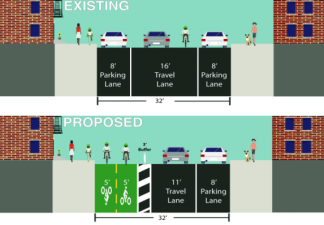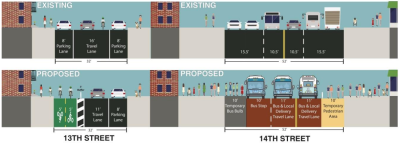The Soft Underbelly of DOT’s L Train Shutdown Plan for 14th Street
Allowing taxi and Uber pick-ups and drop-offs in the busway, even for a maximum of one block, could create serious problems.

DOT released revised details for the 14th Street section of its L train shutdown plan yesterday. It could have been worse, but there are a few weaknesses that stand out.
When the western section of the L train goes out of commission next April, the busiest blocks of 14th Street will be reserved for buses, plus deliveries and passenger pick-ups and drop-offs that will only be allowed on the block of the busway where they have business. Those bus lane rules, plus transit-priority rules on other streets and the Williamsburg Bridge, will be in effect from 5 a.m. to 10 p.m. seven days a week.
In addition, the two-way protected bike lane planned for 13th Street has been divided into two one-way protected bike lanes on 13th and 12th Streets. Like the original 13th Street design, these one-way bike lanes would be separated from car traffic by plastic bollards, not parked cars.
Until yesterday, it wasn’t clear what hours DOT intended the transit-priority rules to remain in effect. Some bus lanes in the city are only reserved for transit a few hours each weekday, around the morning and evening rush. This clearly won’t be sufficient for people who ride the L train, which stays busy long into the night and on the weekends. Advocates and elected officials made 24/7 bus priority a key demand.
DOT’s 17/7 bus lane rules deliver most of what advocates asked for, but there are still some weaknesses in the plan that could cause serious problems.
Bus ridership on 14th Street is expected to remain high until midnight, with at least 1,000 trips per hour for two hours after general traffic will be permitted in the bus lane. If the city is going to impose a cutoff, midnight would have been a better time.
The rules for commercial traffic and other private vehicles may also be too lax. Some exception for local deliveries was always expected, but DOT now says any vehicle making a pick-up or drop-off will be allowed, as long as the driver only uses a single block of 14th Street.
“In accordance with citywide bus lane camera rules, drivers will be able to make any permitted turn on to 14th Street to make a local delivery or passenger pickup/dropoff and then required to make the next right turn off 14th Street,” said a DOT spokesperson. “If a driver continues straight past the right turn, bus lane cameras will issue a violation.”
The camera enforcement is reassuring, but even with the one-block-only rule, allowing access for general pick-ups and drop-offs could jam the busway with taxis and Ubers. There’s very limited capacity for additional vehicles on 14th Street, where the MTA plans to run a bus every minute or so during peak hours.
Splitting the bike lane into two streets, meanwhile, figures to be a mixed bag. On the one hand, each one-way bike lane will be six feet wide, DOT says, providing more total room than the 10-foot two-way bike lane originally planned for 13th Street. On the other hand, expecting people to bike on 12th Street, which is farther from 14th Street, where most people want to get to, could lead to unintended consequences like more people biking on the busway or contraflow on 13th Street.
Key leaders like Mayor de Blasio and Council Speaker Corey Johnson have hung DOT out to dry during this planning process. East Village Council Member Carlina Rivera called for shorter bus priority hours than DOT wanted. The agency has faced intense NIMBY opposition in Johnson’s district. If these officials don’t start standing up for bus priority and safe bikeways and the plan gets watered down further, it’s going to get ugly for transit riders.
The City Council convenes a public hearing on the L train shutdown tomorrow afternoon in the East Village. The meeting begins at 1 p.m. at Benjamin N. Cardozo School of Law/Brookdale Center, Jacob Burns Moot Court Room, 55 Fifth Avenue.



